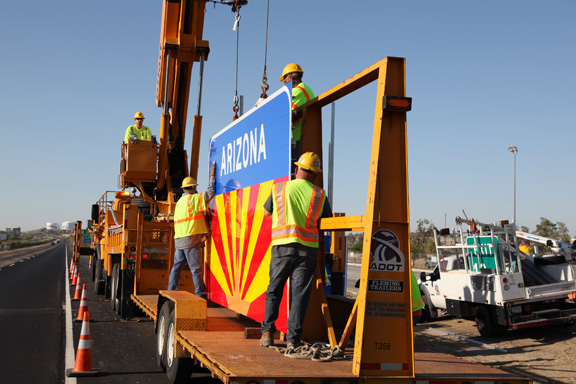Work Zone Awareness Week starts today
Work Zone Awareness Week starts today

Safety is an important topic here on the ADOT Blog. From dust storm info and winter driving tips to seat belt rules and tire pressure guidelines, we try to cover it all...
That’s why you better believe we’re not going to pass up the chance to blog about Work Zone Awareness Week, which gets started today. This is the week that’s observed each year by transportation officials across the country in an effort to increase driver awareness of work zone safety issues.
It’s probably pretty clear why work zone safety is a serious topic at ADOT. Our crews are out in work zones everyday, building and maintaining the state’s highways. Their safety is, of course, a high priority. But, did you know that most of the people killed in highway work zone crashes are drivers and their passengers?
You can see that it’s really important for everyone to make work zone safety a priority.
Drivers play a big role in keeping work zones safe
According to the Federal Highway Administration, most work zone fatalities (about 85-90 percent each year) are motorists and their occupants, and 10-15 percent of fatalities are workers and other non-motorized users such as pedestrians and bicyclists.
“Driver-related factors that affect work zone crashes include speeding, distractions (such as cell phones, texting, and radios), inattentive driving and aggressive driving,” according to the FHWA. “The main type of work zone crash is a rear-end collision, and adequate following distance is important in avoiding such crashes.”
Work Zone Speeding: A Costly Mistake
This year’s theme highlights the fact that speeding is a major factor that contributes to work zone crashes. According to the FHWA, speeding was involved in 36 percent of the fatal crashes that occurred in work zones in 2011.
But, we all know that speed isn’t the only thing you’ve got to pay attention to when you’re driving.
Here’s a good list of driving tips to keep in mind the next time you’re driving through a work zone:
- Slow down. Speeding is among the major causes of work-zone crashes.
- Wear your seatbelt. It is your best defense in a crash.
- Pay attention. Warning signs, directional signs and flaggers are in place to guide you through the work zone safely, so read and obey them. Using a handheld device while driving is never a good idea - especially in work zones. Minimize other distractions that can take your eyes, ears and attention off the road.
- Expect out-of-the-ordinary road conditions. Be ready for lower speed limits, lane restrictions, detours and lots of activity involving workers and equipment next to travel lanes.
- Keep a safe distance between your vehicle and the vehicle in front of you. Rear-end collisions are the most common type of work-zone crashes. Keep a safe distance between your vehicle and construction equipment and crews as well.
- Obey road crew flaggers. Not only does the flagger have information to guide motorists through the work zone safely, but he or she has the same authority as a regulatory sign. Ignore a flagger and you could be cited. Even worse, you could be involved in a serious crash.
- Don’t cut in line ... or try to keep other drivers out. When lanes are narrowed, merge as soon as the signs direct you to do so. Drivers who wait until the last minute to merge (and cut off other drivers) disrupt traffic flow and slow down the commute for everyone. If you’re already in the open travel lane, be considerate and allow other drivers to merge in early.
- Check road conditions and plan accordingly. Schedule enough time to drive safely. By adding a few extra minutes to your commute, you’ll make up for possible work-zone delays. Check for traffic information in advance by calling 511 or by logging on to az511.gov. Never call or log onto the 511 system while driving!
- Be patient and stay calm. Remember: Road crews are working to improve the roadway and your commute.
For more information, visit the FHWA website or check out some of our previous work-zone safety blog posts.
